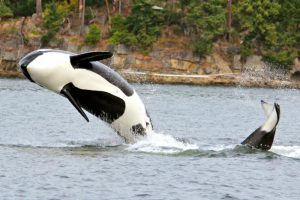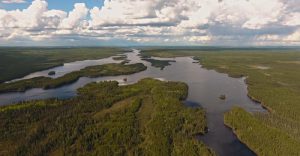
Technology has an incredible capacity to create connections between people. Social media, video conferencing: they all help us communicate with people over long distances and feel more of a physical connection to a person. Now, new technology is being used to do the same thing with researchers and their animal subjects.

Drones, pilotless aircraft, can be used for war, for producing video and as toys. But researchers off Vancouver Island used them to track orca whales and observe their feeding habits.
“When you look at them from above, you see they’re spending most of their time swimming so close together they could touch,” said Lance Barret-Lennard, who has been studying these mammals for 25 years.
“This is how they maintain social bonds. When you see them [doing this], they cease to be these great big, black-and-white things that can eat anything in the ocean and become these fragile animals that we really have to care for. » – Lance Barret-Lennard, researcher
This is more cost effective, allows for more close-up study of the specimens and is safer for the researchers, since they now don’t have to fly out in small planes or helicopters to try and observe species in their natural habitat. According to a 2003 study published in the Wildlife Society Bulletin, 60 U.S Biologists died between 1937 and 2000, the most common cause of death in the field.
They have also been shown to decrease disturbance and distress for animals they observe, Barret-Lennard observing no adverse reaction in the whales he was studying.
David Bird, an emeritus professor of wildlife biology from McGill researchers, said much of the potential for drones is restricted because of tight government regulations, such as only being able to fly drones within eye-sight.

Despite this, he has still been able to make use of the technology; one of his graduate students was able to use a fixed-wing drone to count a colony of common terns on two islands in New Brunswick. Previously, the count would have had to have been done on foot, which causes stress to the birds and risk to the researchers.
Drones do have their drawbacks, for instance not being able to be used in extreme weather conditions, forests, and can sometimes cause injury to birds. Battery life is also a concern, but innovations are being made to try and charge drone batteries wirelessly while they are still flying, giving them infinite power.
Other new technologies include motion-detecting cameras on the ocean floor, which capture sea creatures as they pass, conserving the energy and life-span of the camera. Another innovation is a tiny tracker, known as a geolocator, which fastens to migrating birds. One of these tiny contraptions was able to track a migrating tern from England to the Wendell Sea in Antarctica and back again, a round trip of 96,560 kilometres. and sonic-pulsing “pingers” which warn sea creatures about nearby fishing nets.
All these new technologies allow for animals to be observed in remote locations, keep researchers and the creatures safe, and provide information old methods just can’t contend with. Conservation has entered the future.
Read more about how new technology is transforming the way researchers study wildlife in Canadian Wildlife magazine, Nov + Dec 2017 edition.
